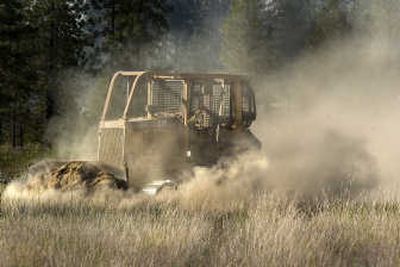Fire chars 155 acres

FORD, Wash. – With blazing hot weather expected later this week, Eastern Washington’s wildfire season got its start Monday.
Though the 155-acre Stevens County fire threatened at least six homes just south of Ford, Wash., by dusk the fire was no longer considered a threat, said Fred Wefer of the Department of Natural Resources.
“They figure to have it pretty well contained tonight – knocked down tonight,” Wefer said Monday.
About 80 area firefighters – from Stevens County Fire District 1, the Bureau of Indian Affairs and the DNR – responded to quell the blaze and protect houses. They planned to resume fighting the season’s first large wildfire about 7 a.m. today, after having it 85 percent contained Monday, Wefer said.
The blaze swept along Chamokane Creek and up steep canyons as firefighters struggled against steady winds and dry terrain. For about four hours, seven aircraft – including two large air tankers from Canada – helped fight from above.
Authorities closed Highway 231 at Corkscrew Canyon Road, where they established a command post. From the highway, a tall column of white smoke rose from a long stretch of dry grass and pine trees.
Several homesteads – their owners gone but their animals trapped – were covered by the smoke. At one home, firefighters kept the blaze away from about a dozen goats in their pen, though several structures were singed.
Authorities did not believe any homes had been destroyed.
Most of the threatened structures were on the east side of the creek; the fire never burned Spokane Indian Reservation land west of the creek, Wefer said.
Firefighters had the most difficulty when the flames started roaring up the steep canyon walls near the creek.
“There’s a lot of fuel in there, and it just burns hot and fast and very intense,” DNR firefighter Russ Hall said.
But by 7 p.m., not long after the air tankers stopped dropping thousands of gallons of red, clay-based fire retardant, crews had cleared a perimeter around most of the main blaze with the help of a bulldozer.
Standard procedure for a fire of such size would have four three-person fire crews patrolling the perimeter during the cool night, Hall said.
Though crews had the wildfire mostly under control Monday night, it could take more than a week to put it out completely, Hall said. Firefighters must extinguish hot spots and make sure nothing is still smoking.
It’s likely to be hot work. The National Weather Service is predicting high temperatures over 90 degrees all week. Meanwhile, land management agencies have been urging Independence Day celebrants to heed the fireworks bans that apply nearly everywhere on public lands – and even on private land in some counties like Spokane.
Monday’s fire is Stevens County’s first mobilization fire – to which more than just local crews respond – of the year, said Rick Anderson, the county’s deputy director of emergency services. Last year, Stevens County had three mobilization fires, he said.